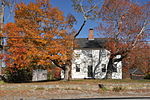Harmony Chapel and Cemetery
1816 establishments in Rhode IslandBuildings and structures in Glocester, Rhode IslandCemeteries on the National Register of Historic Places in Rhode IslandChapels in the United StatesChurches completed in 1816 ... and 4 more
Churches in Providence County, Rhode IslandNational Register of Historic Places in Providence County, Rhode IslandProperties of religious function on the National Register of Historic Places in Rhode IslandUse mdy dates from August 2023

The Harmony Chapel and Cemetery (also known as "Harmony Meeting House" or "Harmony Cemetery") are a historic church and cemetery in Harmony, Rhode Island, a village in Glocester.
Excerpt from the Wikipedia article Harmony Chapel and Cemetery (License: CC BY-SA 3.0, Authors, Images).Harmony Chapel and Cemetery
Putnam Pike,
Geographical coordinates (GPS) Address Nearby Places Show on map
Geographical coordinates (GPS)
| Latitude | Longitude |
|---|---|
| N 41.888888888889 ° | E -71.600277777778 ° |
Address
Harmony Cemetery (Glocester Historical Cemetery Number 35)
Putnam Pike
02829
Rhode Island, United States
Open on Google Maps









